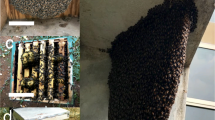Abstract
The "tuned-error" hypothesis states that natural selection has tuned the divergence angle in the dances of the honey bee to produce an optimal scatter of recruits across a resource. Weidenmüller and Seeley (Behav Ecol Sociobiol 46:190–199, 1999) supported this hypothesis by finding smaller divergence angles in dances indicating potential home sites, which are always point sources, than in dances indicating food sources, which often occur in patches. This study tested for the same effect, but controlled for variables, e.g., substrate and context, that may have confounded those results. When performed on the same substrate, divergence angle does not differ between dances for the two resources. Furthermore, dances performed for food within an observation hive exhibit significantly greater divergence angle when performed on comb (as Weidenmüller and Seeley measured food dances) than on hardware cloth (as they measured home-site dances on a swarm). These findings suggest that the angular variance in direction indication in dances is more likely an artifact of physical constraints, rather than an adaptive modification of a behavior that a bee could perform more precisely.





Similar content being viewed by others
References
Camazine S, Visscher PK, Finley J, Vfsetter R (1999) House-hunting by honey bee swarms: collective decisions and individual behaviors. Insectes Soc 46:348–360
Edrich W (1975) The waggle dance of the honey bee: a new formulation. Fortschr Zool (Stuttg) 23:20–30
Gould JL (1976) The dance language controversy. Q Rev Biol 51:211–244
Haldane JBS, Spurway H (1954) A statistical analysis of communication in Apis mellifera and a comparison with communication in other animals. Insectes Soc 1:247–283
Lindauer M (1971) Communication among social bees. Harvard University Press, Cambridge, MA
Seeley TD, Buhrman S (1999) Group decision making in swarms of honey bees. Behav Ecol Sociobiol 45:19–31
Towne W (1985) The spatial precision and mechanisms of the dance communication of honey bees: experimental and comparative studies. Ph.D. thesis, Princeton University Press, Princeton, NJ
Towne W, Gould JL (1988) The spatial precision of the honey bees' dance communication. J Insect Behav 1:129–155
von Frisch K (1948) Gelöste und ungelöste Rätsel der Bienensprache. Naturwissenschaften 35:12–23, 38–43
von Frisch K (1967) The dance language and orientation of bees. Harvard University Press, Cambridge, MA
Weidenmüller A, Seeley TD (1999) Imprecision in the waggle dances of the honeybee (Apis mellifera) for nearby food sources: error or adaptation? Behav Ecol Sociobiol 46:190–199
Wilson EO (1962) Chemical communication among workers of the fire ant Solenopsis saevissima (Fr. Smith). Anim Behav 10:148–158
Acknowledgements
Richard Vetter and Alexis Park provided important assistance with the field work. Richard Redak, Ring Cardé, Jocelyn Millar, and Thomas Seeley improved the manuscript with thoughtful comments on drafts. The Academic Senate, the Department of Entomology, and the Graduate Division of the University of California, Riverside, provided financial support.
Author information
Authors and Affiliations
Corresponding author
Additional information
Communicated by M. Giurfa
Rights and permissions
About this article
Cite this article
Tanner, D.A., Visscher, K. Do honey bees tune error in their dances in nectar-foraging and house-hunting?. Behav Ecol Sociobiol 59, 571–576 (2006). https://doi.org/10.1007/s00265-005-0082-z
Received:
Revised:
Accepted:
Published:
Issue Date:
DOI: https://doi.org/10.1007/s00265-005-0082-z




